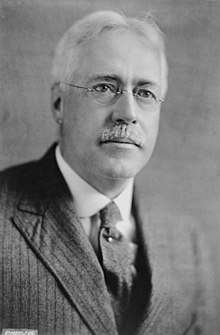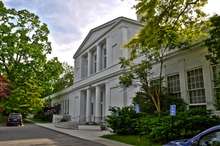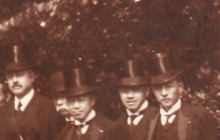Frank A. Vanderlip
Frank Arthur Vanderlip Sr. (November 17, 1864 – June 30, 1937) was an American banker and journalist. He was president of the National City Bank of New York (now Citibank) from 1909 to 1919, and Assistant Secretary of the Treasury from 1897 to 1901. Vanderlip is known for his part in founding the Federal Reserve System and for founding the first Montessori school in the United States, the Scarborough School and the group of communities in Palos Verdes, California.[1]
Frank Arthur Vanderlip Sr. | |
|---|---|
 | |
| President of National City Bank | |
| In office 1909–1919 | |
| Preceded by | James Jewett Stillman |
| Succeeded by | Charles Edwin Mitchell |
| Assistant Secretary of the Treasury | |
| In office 1897–1901 | |
| Personal details | |
| Born | November 13, 1864 Aurora, Illinois |
| Died | June 30, 1937 (aged 72) New York Hospital, Manhattan, New York City |
| Spouse(s) | |
| Children | Narcissa Vanderlip, Charlotte Vanderlip, Frank Arthur Vanderlip Jr., Virginia Vanderlip, Kelvin Vanderlip, and John Vanderlip |
| Parents | Charles Edmond Vanderlip Charlotte Louise Woodworth |
| Known for | Founding Father of Palos Verdes, California |
Born in rural Illinois, Vanderlip worked in farms and factories until beginning a career in journalism in 1885. His efforts in financial journalism led him to become Assistant Secretary of the Treasury until the National City Bank hired him. While president of the bank, Vanderlip worked with the Jekyll Island group to develop a federal reserve; Vanderlip's later proposals also influenced the creation of the Federal Reserve System in 1913. His later life was focused towards developing Palos Verdes and creating the Scarborough School at his estate, Beechwood, in Briarcliff Manor, New York, as well as gentrifying the hamlet of Sparta, Ossining nearby. In addition, he helped found and was the first president of Sleepy Hollow Country Club. Vanderlip died in 1937 in New York Hospital, after weeks of treatment there.
Early life
Frank Vanderlip was born on November 17, 1864 in Aurora, Illinois. Vanderlip was one of several children of Charles Edmond and Charlotte Louise Woodworth Vanderlip. His early life was spent on his family's farm in nearby Oswego, Illinois until his father died in 1878. After his death, Vanderlip, his mother, and his sister moved to Aurora, where he went to work at a lathe in a factory, at the age of 16. After one year at the University of Illinois at Champaign and another job at the factory lathe, Vanderlip became city editor of the local newspaper, the Aurora Evening Post in 1885.
Career
Under the guidance of economist Joseph French Johnson, Vanderlip took a position at a financial investigative service for stock investors in Chicago in 1886. Three years later, in 1889, he became a reporter for the Chicago Tribune, and was promoted to financial editor in 1892. While working for the newspaper, Vanderlip took an extension course in political economy at the newly founded University of Chicago. This brought him to the attention of Lyman J. Gage, who became Secretary of the Treasury under President William McKinley in 1897. Gage hired Vanderlip as his private secretary, six weeks before promoting him to Assistant Secretary of the Treasury.[2] As directed by the War Revenue Act of 1898, Vanderlip was put in charge of sending out the $200 million bond issue to fund the Spanish–American War and procuring the subscriptions, with the special direction to offer the bonds to the smallest subscribers first, so that the public would feel invested in the fight. Vanderlip and his team of 600 to 700 clerks succeeded in selling out the bond issue in just over 30 days, closing out the bond drive on July 14, 1898. Vanderlip's success brought him to the attention of James J. Stillman, president of the National City Bank of New York, then the country's largest bank. Vanderlip became vice president in 1902, and was president from 1909 until 1919.
When the stock market and the financial system collapsed in the Panic of 1907, Vanderlip worked closely with other stable bankers, led by J. P. Morgan, to stop the depositors' run on banks that was leading to economic disaster. As part of an international economic relief response for the Panic of 1907, Vanderlip allied with top Japanese business leaders, hoping they could work together to stabilize the U.S. economy by increasing business and financial relations between their nations. He hoped this would also improve political relations between the U.S. and Japan. Based on these goals, in 1908, Vanderlip led a business U.S. delegation to Japan, where they met with Japanese business leaders, including Baron Shibusawa Eiichi, Baron Shibusawa's son Shibusawa Masao, Baron Takuma Dan, Taka Kawada, and Baron Takamine Mitsui. This 1908 visit was the first official, modern day U.S. business delegation to visit Japan. The 1908 photo to the right presents Vanderlip during that 1908 visit. [3]
The Panic of 1907 had a deep effect on the thinking of Vanderlip and others who were involved. In November 1910, at the invitation of Senator Nelson Aldrich, Vanderlip joined a small group of leading bankers on a train to Jekyll Island, Georgia, which later became known as the Jekyll Island group. The bankers formulated the outline to a plan that laid the groundwork for the drafting of the eventual Federal Reserve Act.[2] In the final month and a half before the act's enactment on December 23, 1913, Vanderlip's alternative plan for a Federal Reserve Act nearly derailed the one that President Wilson and the Democratic leadership were promoting.[4][5] Several of Vanderlip's ideas were incorporated into the final Federal Reserve Act.
During the Teapot Dome Scandal hearings in 1924, Vanderlip testified about what he believed to be a scandal during the administration of President Warren G. Harding. Because he spoke out vigorously in defense of the public's right to know about various issues, Vanderlip was forced to resign from the boards of directors of almost 40 companies. He subsequently led a quieter life at his homes in New York and California.
After two weeks' hospitalization at New York Hospital, Vanderlip died there on June 30, 1937, at age 72.[1]
Personal life and purchases

On May 19, 1903, Vanderlip married Mabel Narcissa Cox (Narcissa Cox Vanderlip) in her home town of Chicago, Illinois. In 1905, they purchased Beechwood, on the Hudson in the hamlet of Scarborough, in Briarcliff Manor, New York. There they founded the Scarborough School, the first Montessori school in the US.[6]
Vanderlip purchased several other large parcels, often along with other investors. The Vanderlip-Stillman-Tilghman syndicate bought 15,000 acres (6,100 ha) of land at the mouth of the Brazos River in Texas, in 1912, and founded the city of Freeport. After several smaller land investments, Vanderlip spearheaded a group that bought 16,000 acres (6,500 ha) now known collectively as Palos Verdes, California. Vanderlip, known as the "Father of Palos Verdes" purchased the 16,000 acres (6,500 ha) Rancho de los Palos Verdes from Jotham Bixby in 1913. In 1916, he built the Vanderlip estates near the Portuguese Bend area of Palos Verdes, California where some of his descendants still live.[7] The Vanderlips helped develop landmarks in Rancho Palos Verdes, notably Wayfarers Chapel, Marineland of the Pacific, Portuguese Bend Riding Club, Portuguese Bend Beach Club, Nansen Field, Marymount College and Chadwick School.[8] His original purchase is now divided into four cities: Palos Verdes Estates, Rolling Hills Estates, Rolling Hills, and Rancho Palos Verdes.
His last major purchase was the hamlet of Sparta in Ossining, a quarter-mile from his Beechwood home. He bought about 70 homes and business buildings in 1920, believing it to be too run-down. Tearing down dilapidated homes, turning some to face the river, and moving at least one across the street, Vanderlip beautified and gentrified Sparta. Some of these buildings became homes for teachers at Scarborough School. The Vanderlips later gave land in Scarborough to one of their daughters, Narcissa, and her husband Julian Street Jr., for their family home, the Julian Street Jr. residence.
Legacy

Frank Vanderlip was an innovator in the world of banking. Besides being one of the founders of the Federal Reserve System, he led his bank to open the first overseas branches of an American bank, helped devise the war bond savings stamp program used in World Wars I and II, set up the first internship program to bring college students to work and study in the bank. He also worked to open up friendly business and personal relations with Japan in the 1920s.
Selected works
- Vanderlip, Frank A. The American "commercial invasion" of Europe. Republished from Scribner's Magazine, 1902. Retrieved November 16, 2016.
- Vanderlip, Frank A.; Sparkes, Boyden (February 9, 1935). "From Farm Boy to Financier: Stories of Railroad Moguls" (PDF). The Saturday Evening Post. Retrieved July 18, 2014.
References
- "Frank Vanderlip, Banker, Dies At 72. Former Head of National City Had Served as Assistant Secretary of Treasury". The New York Times. June 30, 1937. Retrieved September 16, 2012.
- Mack, Vicki A. (2013). Frank A. Vanderlip: The Banker Who Changed America. Palos Verdes Estates, California: Pinale Press. ISBN 978-1492704904.
- "1908 Photo – Frank A. Vanderlip future president of the Japan Society of New York City leads the first official, modern day U.S. business delegation to Japan to meet with Shibusawa Eiichi and representatives of Mitsui & Co., and other Japanese business leaders". TheEmperorAndTheSpy.com.
- "Change Money Bill on Vanderlip Lines". The New York Times. November 7, 1913. Retrieved July 5, 2016.
- Johnson, Roger T. (1999). Historical Beginnings... The Federal Reserve (PDF). Federal Reserve Bank of Boston. pp. 30–31. Retrieved July 5, 2016.
- Cheever, Mary (1990). The Changing Landscape: A History of Briarcliff Manor-Scarborough. West Kennebunk, Maine: Phoenix Publishing. ISBN 0-914659-49-9. OCLC 22274920.
- Brown, Frank (June 19, 2008). "Vanderlip family remains a presence on the Hill". Palos Verdes Peninsula News. Retrieved July 5, 2016.
- Lowrie, Katharine Blossom (February 9, 2011). "Elin Vanderlip: The Chatelaine of Rancho Palos Verdes". Palos Verdes Patch. Retrieved July 5, 2016.
- Bibliography
- Brooks, Frank H. (May–October 1902). "Frank A. Vanderlip". The World's Work. New York, New York: Doubleday, Page & Company. 4: 2185–90. Retrieved July 5, 2016.
Further reading
- Mack, Vicki A. (2013). Frank A. Vanderlip: The Banker Who Changed America. Palos Verdes Estates, California: Pinale Press. ISBN 978-1492704904.
- Mack, Vicki A. (Director) (November 13, 2015). Money Man: Frank Vanderlip and the Birth of the Federal Reserve (motion picture). Duck Pond Productions.
External links
![]()
- Frank A. Vanderlip Papers at the Columbia University Rare Book and Manuscript Library, New York, NY
- Newspaper clippings about Frank A. Vanderlip in the 20th Century Press Archives of the ZBW
| Business positions | ||
|---|---|---|
| Preceded by James Stillman |
Chief of National City Bank 1918–1919 (President with acting duties as Chairman) |
Succeeded by James A. Stillman |